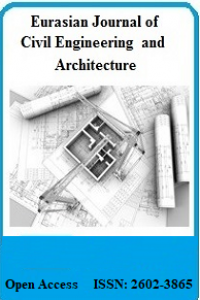ANALYSIS OF THE WATER USE IN DIFFERENT TYPES OF BUILDINGS
ANALYSIS OF THE WATER USE IN DIFFERENT TYPES OF BUILDINGS
___
- Adamowski J. F. (2008). "Peak daily water demand forecast modellinging using artificial neural networks." Journal of Water Resources Planning and Management, Vol. 134, No 2, pp.119-128.
- Alitchkov D. K. (1998). "Implementation of stochastic model for simulation of the flow rates in the water supply and drainage systems for buildings." Proc.,CIB W62 Symposium on Water Supply and Drainage for Buildings, Rotterdam, Netherlands.
- Alvisi S., Franchini M., Marinelli A. (2007). "A short-term, pattern-based model for water-demand forecasting." Journal of Hydroinformatics, Vol. 9, No 1.
- Brentan B. M., Luvizotto J., Herrera M., Izquierdo J., Perez-Garca R. (2017). "Hybrid regression model for near real-time urban water demand forecasting." Journal of Computantional and applied mathematics, Vol. 309.
- Buchberger S. (2018). "Estimating Peak Water Demands in Buildings with Efficient Fixtures." Proc., Progress and Prognosis, Emerging Water Technology Symposium, Cincinnati, USA .
- Dobromislov A., Verbitzkii A. S., Ljakmund A. L. (2007). " Handbook for estimation of the flow rates in water supply and drainage system of buildings and reagions(in Russian)." Santehniiproekt, Moscow.
- Gagliardi F., Alvisi S., Kaplan Z., Franchini M. (2017). "A probabilistic short-term water demand forecasting model based on the Markov Chain." Journal Water, Vol. 507, No 9.
- Gargano R. et al. (2017). "Probabilistic models for the peak residential water demand." Journal of Water, Vol. 417, No 9.
- Ghiassi M., Zimba D., Saidane H. (2008). "Urban water demand forecasting with dynamic artificial neural network model." Journal of Water Recources Planning and Management, Vol. 34, No 2, pp. 138-146.
- Herrera M., Torgo L., Izquiero J., Perz-Garcia R.(2010). "Predictive models for forecasting hourly urban water demand." Journal of Hydrology, Vol. 387.
- House-Peters L.A., Chang H. (2011). "Urban water deman modeling:Review of conceps, methods, and organizing principles. "Water Resources Research, Vol. 47, No5.
- Konen T. P., Goncalves O. M. (1993). "Summery of mathematical models for the design of water distribution systems within buildings." Proc., 20th CIBW062 International symposium of water supply and drainage systems in buildings, Porto, Portugal.
- Shrestha D., Solomatine D. (2007). "Predicting hydrological models uncertainty: use of machine leaning." Proc., 32-nd IAHR World Congress, Venice, Italy.
- Tiwari M. K., Adamowski J. (2013). Urban water demand forecasting and uncertanty assessment using ensemble wavelet-bootstrap-neural network models." Jurnal of Water resources research, Vol. 49, No10.
- Verbitsky A. S. (1993). "Mathematical models for calculation of water supply networks based on their stochastic characteristics." Integrated Computer Applications in Water Supply, Vol.1, Research Studies Press, Hertfordshire.
- Wong L. T., Mui Kwok-Wai (2018). "Review of demand models for water systems in buildings including a Bayesian approach." Journal of Water, Vol. 10, No.8.
- Başlangıç: 2017
- Yayıncı: Serkan ŞAHİNKAYA
INVESTIGATION OF FLUID-STRUCTURE INTERACTION BY USING SOLIDITY RATIO
Begum Yurdanur DAGLİ, Yesim TUSKAN, Dilay UNCU
SURFACE FLOW, URBAN AND LAND-BASED POLLUTION LOADS IN DAVUTLAR BAY
Ayşe EDİNÇLİLER, Yasin Sait TOKSOY
EXAMINING THE COMPONENTS OF GREEN BUILDING DESIGN AND ITS MANAGEMENT SYSTEM
Mohammad BEYKZADE, Sepide BEYKZADE
EFFECT OF LIME ON UNCONFINED COMPRESSIVE STRENGTH OF A LOW PLASTICITY CLAYEY SOIL
Mustafa KARASAHİN, Erdinç KESKİN, İlker ŞAHİNOĞLU
